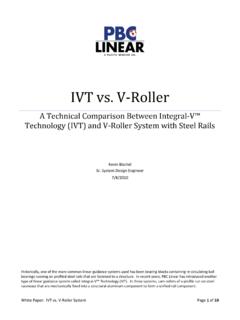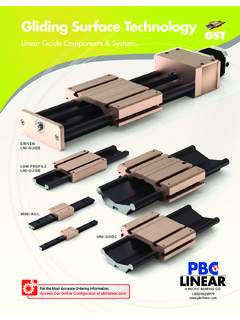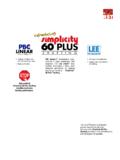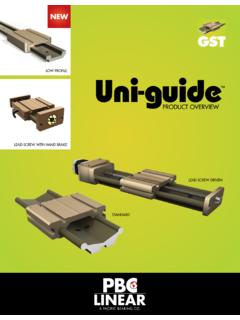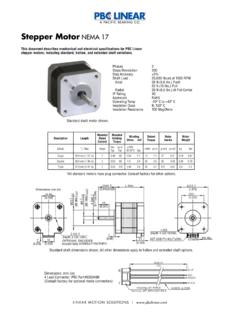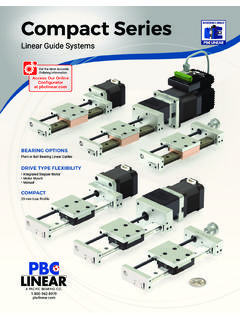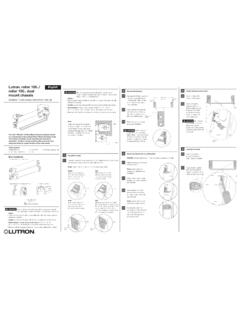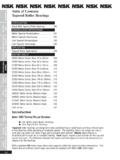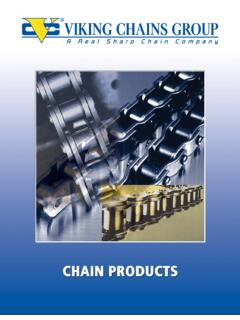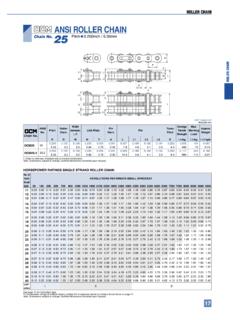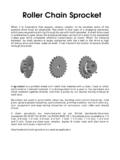Transcription of The Facts About Roller Bearing Life Calculations
1 The Facts About Roller Bearing Life Calculations How to Properly Calculate the Statistical Probability of Lifetime for Linear Roller Bearing Applications 2013 PBC Linear , A Division of Pacific Bearing Company . PBC Linear , A Pacific Bearing Company March 2013. The Facts About Roller Bearing Life Calculations How to Properly Calcuate the Statistical Probability of Lifetime for Linear Roller Bearing Applications Introduction: Important Notice About Lifetime Calculations There is no known formula for accurately and reliably calculating the actual lifetime of a linear or rotary Bearing system. The formulas within this section are solely based upon the statistical probability of success. It is important to recognize and distinguish between formulas of absolute certainty and probability. Even though these formulas are not absolutely certain, they have been generally accepted as the best available method for determining Bearing lifetime by the International Organization for Standardization (ISO) as well as its membership bodies; including, but not limited to: American National Standards Institute (ANSI), Deutsches Institut f r Normung (DIN) & Japanese Industrial Standards Committee (JISC).
2 Static & Dynamic Load Ratings PBC Linear uses the two internationally accepted methods for calculating the Rated Lifetime, Static and Dynamic Capacities. Per the international standard, all lifetimes are calculated to an L10 life of 100 km (105 meters or million inches). The two standards used are: ISO76 Rolling Bearings Static Load Ratings ISO281 Rolling Bearings Dynamic Load Ratings & Rating Life NOTE: Some suppliers may choose to rate their bearings based upon a useful life of less than 100 km or a probability of success less than 90%. This causes their bearings to falsely appear to have a higher static and dynamic load capacity. If a catalog does not specifically note L10 = 100 km, caution should be used when comparing load capacity or life values between suppliers. The most commonly used values are L10 = 50 km and L25 = 50 km. For comparison, at L10 = 100 km, an example Bearing has a maximum static load of 1,000 N. That exact same Bearing as an L10 =.
3 50 km maximum static load of 2,300 N and an L25 = 50 km maximum static load of 4,600 N! In summary, the static load ratings are defined as the maximum applied load (or moment) which will result in the permanent deformation which does not exceed 1/10,000 of the diameter of the rolling LITTWPGEN-013 Page 2 of 14. PBC Linear , A Pacific Bearing Company March 2013. element (ball or rod) within the Bearing . The basic dynamic load rating, C, is the load of a constant magnitude and direction which a sufficiently large number of apparently identical bearings can endure for a basic rating life of one million revolutions. It's important to note that both the static and dynamic values are determined though ISO-Approved formulas. These formulas take into account several factors, including the design, internal geometry, material type, material quality and lubrication type. NOTE: Additional factors are provided so that the estimated lifetime (default = 100 km) and/or the probability of success (default = 90%) can be changed from their default value to any desired value.
4 Operating Lifetime The Operating Life (or Operating Lifetime) is the actual life achieved by a rolling Bearing . The actual lifetime typically varies from the calculated lifetime, sometimes significantly. It is not possible to accurately and reliably determine the actual Operating Life through Calculations due to the large variety of operating and installation conditions. The most reliable method to achieve an approximation is by comparing the current application to similar applications. Primary factors which can negatively affect the life and are generally not included in Calculations are: Contamination within the application Inadequate or improper lubrication Operational conditions different from calculated values, including unexpected forces and moments Insufficient and/or excessive operating clearance between the Roller & guideway Excessive interference between Roller & guideway (typically due to misalignment or excessive preload).
5 Temperature out of range High shock loads (exceeding static load capacity). Vibration (which causes False Brinelling resulting from Fretting). Short stroke reciprocating motion (also causes False Brinelling). Damage caused during installation or from improper handling Improper mating surface hardness (when not used with a PBC Linear rail). LITTWPGEN-013 Page 3 of 14. PBC Linear , A Pacific Bearing Company March 2013. Terms, Definitions and Symbols The following variables are used within the equations listed on the following pages. Fy_ap p = Force applied in the Y direction ( force), . Fz_app = Force applied in the Z direction ( force), . Mx_app = Moment applied About the X axis, . My_app = Moment applied About the Y axis, . Mz_app = Moment applied About the Z axis, . Fy_max = Maximum allowable force in the Y direction ( force), . Fz_max = Maximum allowable force in the Z direction ( force), . Mx_max = Maximum allowable moment About the X axis.
6 My_max = Maximum allowable moment About the Y axis, . Mz_max = Maximum allowable moment About the Z axis, . a = rolling contact diameter, from product tables, . fH = Shaft (rail)hardness reduction factor fL = Required Lifetime (km) reduction factor fR = Reliability reduction factor fSS = Short stroke reduction factor L10 = Basic rating life, (103 ). Pr = Equivalent radial Fy load, . s. f = safety factor NOTE: PBC has chosen to depart from the nomenclature standards used by ISO. Instead, PBC has chosen to use a convention which is more in line with other PBC products. This ensures that all PBC products use the same naming conventions, making it easier to compare multiple products from different product families. LITTWPGEN-013 Page 4 of 14. PBC Linear , A Pacific Bearing Company March 2013. Derivation The lifetime formula within ISO 281 gives the life in millions of revolutions. The conversion from rotary life to linear life is done using the conversion factors listed in the following three equations.
7 This derivation applies to both individual rollers and carriages. Lrev and Ldistance represent the lifetime of the Bearing in revolutions and linear distance, respectively. 1 105 Eq. 1. [1 105 ] = [1,000,000 ] . 100,000,000 . [1 105 ] = ( ) Eq. 2. [ ] = 100 ( ) = Eq. 3. NOTE: Attention must be paid to units of measure, especially when considering products from different manufacturers. All of the lifetime formulas within this section yield results in kilometers;. however, not all companies follow the same standard. Some companies may express life in meters or 100's of kilometers. Individual Rollers All products except Hevi-Rail Rollers (see next section for Hevi-Rail Rollers). Most of the individual rollers within this catalog are Radial Ball Bearings. The following formulas should be used for all individual bearings except Hevi-Rail bearings (which are Roller bearings). This formula calculates the basic rating life (L10 life), which does not take into account any reduction factors based upon the application.
8 Fymax 3 Eq. 4. 10 [ ] = ( ).. = Fy_ap p + Fz_app Eq. 5. The values for X & Y can be found using the table listed on the following page . LITTWPGEN-013 Page 5 of 14. PBC Linear , A Pacific Bearing Company March 2013. Table 1: Values of X & Y for Radial Ball Bearing Life Formula Fz_app Fz_app > . Fy_ap p Fy_ap p Product . X Y X Y. Commercial Rail (all sizes) 1 0 .41 .87 .68. Hardened Crown Rollers 1 0 .41 .87 .68. Integral-V (IVT) (Compact Linear Guides) 1 .78 .63 .8. Integral-V (IVT) (all other sizes & types) 1 .78 .63 .8. Redi-Rail (all sizes & types) 1 .78 .63 .8. Steel-Rail (all sizes & types) 1 .78 .63 .8. V-Rail (all sizes) 1 .78 .63 .8. Individual Rollers Hevi-Rail Rollers Hevi-Rail bearings are Roller bearings, as opposed to radial ball bearings. The formulas are very similar to the formulas shown above, with only some minor changes. Eq. 6. Fy . _10 [ ] = max ( ).. Eq. 7. Fy . _10 [ ] = max ( ).. NOTE: Hevi-Rail rollers are combined bearings.
9 Essentially there are two bearings combined into one. Life Calculations should be performed for both the radial and the axial Bearing . LITTWPGEN-013 Page 6 of 14. PBC Linear , A Pacific Bearing Company March 2013. Carriage (Slider) Assemblies Formulas for calculating the estimated lifetime for carriage assemblies are fundamentally similar to the Calculations for the individual rollers. The most accurate method for determining the life of a carriage (slider) assembly is to create a free body diagram for the carriage and determine the axial, radial and moment load applied to each individual Roller . This method is cumbersome and is usually only required in the most severe of circumstances. In most cases, the carriage (slider) assembly can be treated as a rigid body and Calculations can be completed based upon the load ratings for the entire carriage (slider). 1. 3. Eq. 8. 10 [ ] = 100 + + + + ( ). _ _ _ _ _ . Safety Factor All individual rollers and carriages are subject to use a balancing formula which ensures an adequate product life.
10 The following formulas should be used for all CRT Products. 1 _ _ _ _ _ Eq. 9. Carriages + + + +.. _ _ _ _ _ . 1 _ _ Eq. 10. Individual Bearings +.. _ _ . Where the safety factor value can be determined using the following table. Table 3. ( .. ). Duty Shock/Vibration Reverse frequency Contamination .. Very Light None Smooth & Low None Light Light Light Light Medium Medium Medium Medium Heavy Heavy High & Fast Heavy LITTWPGEN-013 Page 7 of 14. PBC Linear , A Pacific Bearing Company March 2013. Note: The table above contains suggested safety factors based upon the most commonly encountered adjustment criteria. Additional criteria may require raising the safety factor. Minimum Load Notice It is possible to apply too small of a load to a Bearing /carriage. In this case, there is a possibility of the outer ring slipping or the Roller lifting off the track. This can cause unexpected vibration or skidding which will reduce the life of the Bearing .
